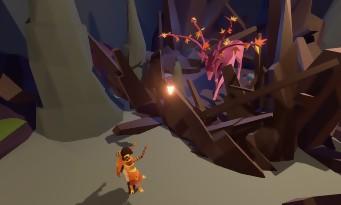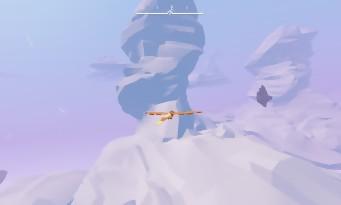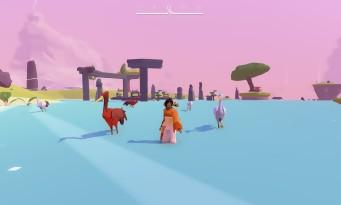 Auk is a girl of the Sky People, so named because her lands are made up of islets floating in the air, and the day has come for her to perform a Pilgrimage. But now she acquires during this rite a strange lantern, which allows her to make silhouettes of the past appear and to trigger mechanisms as ancient as they are mysterious. That's all it takes for Auk to start visiting the three or four temples around her. For the player, it's about solving some never frustrating puzzles and above all exploring an enchanting world. In order to reinforce the immersion, the developers had the intelligence to never explain the mechanisms of the puzzles to us, and to ignore almost any interface. No marker to tell you where you should go, but a simple compass and characters that tell you that such a place is east or northwest of where you are now. It's a real pleasure not to be taken by the hand... and for a fool. Moreover, it is even possible to discover the world as you wish, without even following the instructions of anyone. If you feel like visiting the northern islets at the start of the game, no problem.
Auk is a girl of the Sky People, so named because her lands are made up of islets floating in the air, and the day has come for her to perform a Pilgrimage. But now she acquires during this rite a strange lantern, which allows her to make silhouettes of the past appear and to trigger mechanisms as ancient as they are mysterious. That's all it takes for Auk to start visiting the three or four temples around her. For the player, it's about solving some never frustrating puzzles and above all exploring an enchanting world. In order to reinforce the immersion, the developers had the intelligence to never explain the mechanisms of the puzzles to us, and to ignore almost any interface. No marker to tell you where you should go, but a simple compass and characters that tell you that such a place is east or northwest of where you are now. It's a real pleasure not to be taken by the hand... and for a fool. Moreover, it is even possible to discover the world as you wish, without even following the instructions of anyone. If you feel like visiting the northern islets at the start of the game, no problem. The adventure does not ask you to eliminate anyone and it is impossible to die (a simple and gentle reappearance will follow a voluntary fall into the void). Exploration is therefore never punished, nor even artificially rewarded for that matter. There are no objects to collect, but texts to discover to learn more about the local gods and the Great Dislocation, responsible for the disappearance of the mainland. And if, during a visit to an islet, you feel like taking a break among the herons, running after deer or frolicking with a young sheep, don't deprive yourself of it. The ride in the world of AER is a gratification in itself. Sometimes you'll come across an animal spirit or a gigantic statue, and these simple discoveries will give you at least as much pleasure as if the game rewarded you with artificial experience points or some monkey money.
The adventure does not ask you to eliminate anyone and it is impossible to die (a simple and gentle reappearance will follow a voluntary fall into the void). Exploration is therefore never punished, nor even artificially rewarded for that matter. There are no objects to collect, but texts to discover to learn more about the local gods and the Great Dislocation, responsible for the disappearance of the mainland. And if, during a visit to an islet, you feel like taking a break among the herons, running after deer or frolicking with a young sheep, don't deprive yourself of it. The ride in the world of AER is a gratification in itself. Sometimes you'll come across an animal spirit or a gigantic statue, and these simple discoveries will give you at least as much pleasure as if the game rewarded you with artificial experience points or some monkey money.
PURE AIR
 If the exploration is so pleasant, it is partly due to the deliberately stingy artistic direction in polygons, whose style can confuse at first glance but ends up inevitably seducing. The sound aspect is not to be outdone, the natural sound effects and the relaxing music contributing to the zen and slightly nostalgic atmosphere in which the adventure is immersed. But the biggest strength of the game certainly comes from the possibility of flying. Auk can at any time (except when she is in a cave or a temple) transform into an eagle and take flight in order to join the different islets that form the world of AER. The result is an exhilarating feeling of freedom, and you regularly find yourself gliding, flapping your wings and crossing the clouds with no other goal than the flight itself. Sharing game time between exploration and puzzles works very well, especially since the latter only require a few keys (jump, action, lantern) and a few neurons to be solved. We are far from the complexity of a Myst, and so much the better! Any excessive headache would have harmed the general atmosphere. On the other hand, it must be recognized that the game is very short. You will see the end of the adventure after three hours, even though the end lacks a bit of chest. We can also blame the game engine for imposing a loading time on us as soon as we enter or leave a closed place. A real open world without any loading screen would have enhanced the immersion even more. But these small faults do not weigh heavily in the end compared to the feeling of having lived an adventure apart, which has its place perfectly alongside the Flower, Journey and other ABZÛ.
If the exploration is so pleasant, it is partly due to the deliberately stingy artistic direction in polygons, whose style can confuse at first glance but ends up inevitably seducing. The sound aspect is not to be outdone, the natural sound effects and the relaxing music contributing to the zen and slightly nostalgic atmosphere in which the adventure is immersed. But the biggest strength of the game certainly comes from the possibility of flying. Auk can at any time (except when she is in a cave or a temple) transform into an eagle and take flight in order to join the different islets that form the world of AER. The result is an exhilarating feeling of freedom, and you regularly find yourself gliding, flapping your wings and crossing the clouds with no other goal than the flight itself. Sharing game time between exploration and puzzles works very well, especially since the latter only require a few keys (jump, action, lantern) and a few neurons to be solved. We are far from the complexity of a Myst, and so much the better! Any excessive headache would have harmed the general atmosphere. On the other hand, it must be recognized that the game is very short. You will see the end of the adventure after three hours, even though the end lacks a bit of chest. We can also blame the game engine for imposing a loading time on us as soon as we enter or leave a closed place. A real open world without any loading screen would have enhanced the immersion even more. But these small faults do not weigh heavily in the end compared to the feeling of having lived an adventure apart, which has its place perfectly alongside the Flower, Journey and other ABZÛ.


























